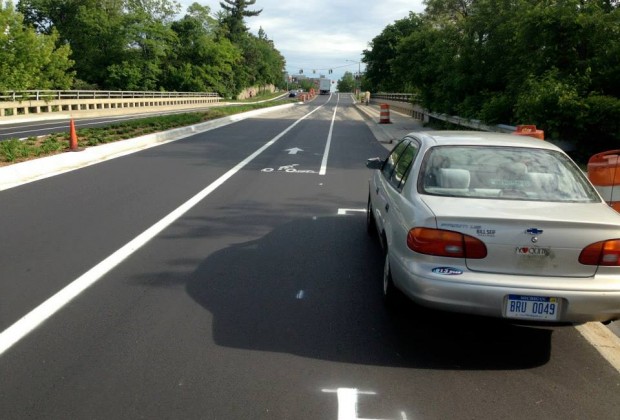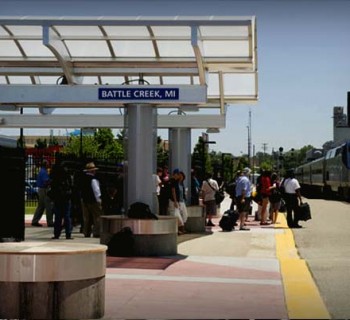LANSING—As we roll into 2014 and Michigan’s Complete Streets Advisory Council prepares to sunset, the Michigan Department of Transportation will attempt get its own house in order to tackle Complete Streets 15 months after the state-wide policy was adopted.
MDOT is undertaking two internal initiatives to support Complete Streets implementation. The first is a Complete Streets Policy Implementation Plan designed to codify procedures for community outreach across all MDOT regions.
“Projects get developed so far in advance of their construction, it’s critical to involve those stakeholders up front,” says Polly Kent, MDOT’s intermodal policy administrator. “It’s really difficult once the project has already been designed and commissioned to come in and add complete streets changes.”
The implementation plan, according to Kent, is designed to make sure MDOT is communicating with local communities well in advance of it’s projects with consistent protocol, tracking and reporting.
“MDOT has been nationally recognized for our context-sensitive solutions process,” says Kent. “We’ve already been doing a good job of reaching out; this implementation plan will make that more consistent and better documented.”
The second initiative is a Multimodal Design and Delivery project, which will create an agency-wide curriculum for MDOT staff on universal access to transportation systems. MDOT may make the curriculum available to local road agencies later this year.
“The curriculum will be designed to help MDOT better integrate all users in all modes,” says Kent.
Jeff Cranson, director of communications for MDOT, notes that while MDOT was involved in drafting Michigan’s Complete Streets Policy, the agency’s role in implementation is limited by jurisdiction.
“We have no authority over roads that are not our trunk lines,” says Cranson. “We have fewer than 10 percent of roads in the state; we can only do so much.”
Kent notes that local road agencies and local governments play a critical role in making their wishes known to MDOT.
“If cities, villages and townships want Complete Streets and ask us, then we will look at it, but its not like we are driving the policy,” says Kent. “We want to make streets safe for all users, but it’s very nuanced when you go to talk to communities; we want to find out what they want. It’s not a notion that we are planting.”
MDOT has come a long way in its regard for multimodal transportation, according to Cranson.
“While there are advocates for multimodal transportation who feel like things aren’t happening fast enough, we are a more multimodal agency now than we’ve ever been in our 108-year history,” he says.
John Lindenmayer, Executive Director of the League of Michigan Bicyclists and member of the Complete Streets Coalition, an advocacy group for Complete Streets in the state, thinks MDOT is on the right track.
“I’m really excited that hear that MDOT is on track to update their internal workings to fully implement Complete Streets,” says Lindenmayer. “It’s encouraging to hear that MDOT plans to publicly track Complete Streets projects, along with investing in training staff on their policy. It’s great to hear too that MDOT plans on actively sharing lessons learned to other regional and local governments. This is really where Complete Streets needs the most attention moving forward.”
Lindenmayer is less enthusiastic about the demise of CSAC, however, noting that Complete Streets design and planning is a constantly evolving process and needs continual leadership.
“It’s a moving target, so to pack up and go home, seems like a strange move,” he says. “The CSAC is a unique body of expertise that LMB and other advocates fought hard to have included within the law.”
Lindenmayer is particularly concerned that as more local governments and agencies start adopting complete streets policies, an absence of statewide leadership on the issue will hinder their efforts.
“The CSAC has the unique opportunity to provide more leadership on this issue, especially when it comes to providing guidance to local communities,” he says. “This was actually part of their mandate as well. The CSAC spent very little effort reaching out to locals and developing tools and best practices to assist at this level.
"There are a lot of communities who are excited, who’ve taken important first steps by adopting resolutions and ordinances, and are now saying, ‘OK, great, now how do we do it?’ For the CSAC to bow out of the conversation now seems to be a missed opportunity to be innovative and advance Complete Streets further and faster across the state.”
Cranson says the discontinuance of CSAC should in no way be taken as a sign or symbol of MDOT losing interest in Complete Streets as a policy.
“They’ve done what they were charged to do,” says Kent. “They led the transportation commission to develop a statewide policy, they developed local policies for local communities to customize, and they represented a broad range of constituencies.”
Perhaps more important than state leadership is funding, notes Cranson.
“We would be remiss if we didn’t mention the fact that there needs to be more investment in transportation,” says Kent. “These solutions don’t have to be costly, but we are having trouble just keeping the pavement in order right now.”
Cranson notes that one problem facing local agencies is they aren’t doing the kinds of road fixes that might open them up for complete streets, because they are busy trying to keep up with patching potholes.
“Even though the cost of paint for a bike lane is inexpensive, when programs get to the bare bones, and it’s paint vs. potholes, it looks like a big expense.”
Do you think MDOT is on the right track? Tell us in the comments below.










